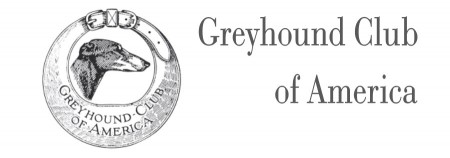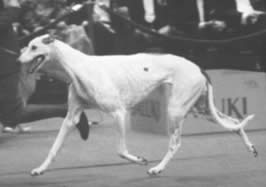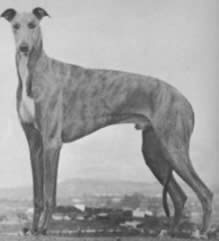Greyhound Type - The Archtypical Sighthound
 The Greyhound is the archtypical sighthound, it’s “type” is universally recognized all over the world. All other sighthound breeds, separate and distinct as they are, can be described relative to the Greyhound.
The Greyhound is the archtypical sighthound, it’s “type” is universally recognized all over the world. All other sighthound breeds, separate and distinct as they are, can be described relative to the Greyhound.
Since ancient times, sighthounds have coursed wild game for man, and for reasons lost in time, the Greyhound became the fastest breed of dog. Since the development of the Greyhound predates written texts and occurred in many geographical regions, we have no record of a specific purpose, place or people to tie it to, unlike the Borzoi and Whippet.
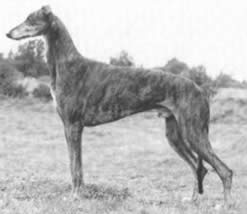
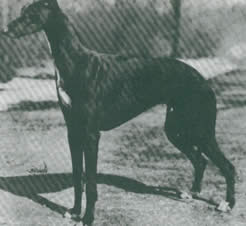
Greyhound Type is powerful, smooth, S-shaped.
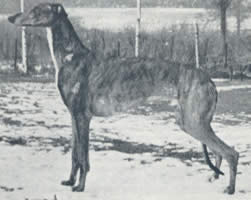
Greyhound Type is deep-chested, well muscled, stands over a lot of ground, has good, hard feet, and a long whip-like tail.
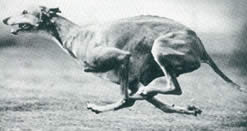
And above all else, Greyhound Type is FAST. Greyhound Type is made fast by the singular combination of skeletal structure, musculature, and the ability to focus completely on the object of the chase. Greyhound-type dogs evolved the double suspension gallop into its highest canine form in the Greyhound breed.
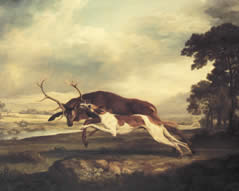
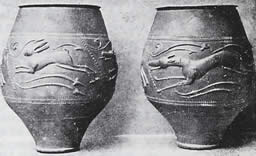
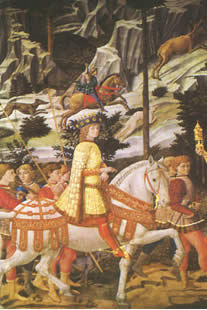
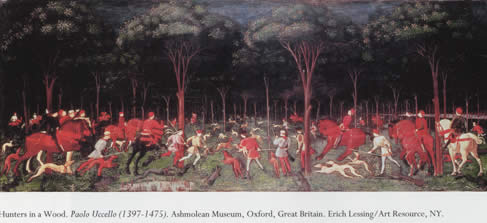
 Varied game, varied terrain… These ancient artworks come from all over the civilized world, indicating the Greyhound was adaptable to a variety of terrain and climates. Most recently, the sport of coursing developed in England during the reign of Queen Elizabeth the First, and royal interest in this sport helped shape the modern Greyhound. Indeed, our AKC Greyhounds of today trace directly to imports from England.
Varied game, varied terrain… These ancient artworks come from all over the civilized world, indicating the Greyhound was adaptable to a variety of terrain and climates. Most recently, the sport of coursing developed in England during the reign of Queen Elizabeth the First, and royal interest in this sport helped shape the modern Greyhound. Indeed, our AKC Greyhounds of today trace directly to imports from England.
Racing Greyhounds have only been bred for about one century, and are specialists at running full speed in a single direction. They have been selected for speed without regard for endurance or agility as track races are quite different from the changes in speed and direction needed when coursing live game over varied terrain. These differences in purpose have led to structural differences between modern show Greyhounds and the track dogs. Today, we are talking about Show Greyhounds.
“A greyhound should be headed like a snake and necked like a drake, backed like a beam, sided like a bream, footed like a cat and tailed like a rat”.
How does one describe a breed whose very type personifies a whole family of breeds? A description from the year 1486 gives perhaps the most concise statement of the fundamental essentials of the breed throughout history.
No mention of a desired color, or coat, or size, or weight. Those details were not important to a good Greyhound, but do make up a good portion of the differences between Greyhounds and other sighthound breeds.
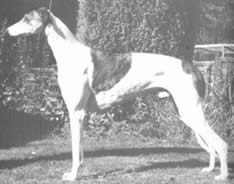
Greyhounds are strongly built, muscular and symmetrical, with strong loin and powerful quarters.
More modern descriptions can be found in the AKC and English standards of perfection. These standards have been blended for our discussion of TYPE today.
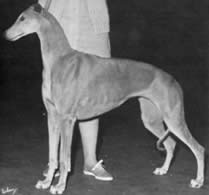
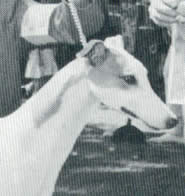
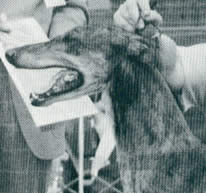
 Long muscular neck, clean throat. Oblique shoulders, forelegs perfectly straight, pasterns strong.
Long muscular neck, clean throat. Oblique shoulders, forelegs perfectly straight, pasterns strong.
The neck is long, strong, muscular and graceful. It is a gentle arch blending smoothly into the withers, and contributes to the total balance of the dog.
The very long shoulder blades are laid back and incline towards each other at the top as they approach the withers, separated by about three fingers width across the top. The upper arm is equally as long and angles back from the point of the shoulder to the elbow. The angle formed by the shoulder blade and upper arm is rather more open than that of trotting breeds, but should never be upright.
The bones of the forelegs are finely bladed and strong, viewed from the front, they should be perfectly straight from elbow to foot. Pasterns are very strong, and only slightly sloped when viewed from the side. Pasterns undergo a great deal of stress at the gallop.
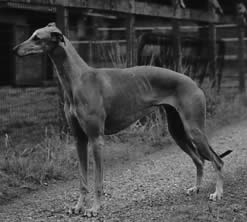 Chest deep, wide as consistent with speed, fairly well sprung ribs. Broad muscular back, loins well arched with deep muscle, and cut up in flanks.
Chest deep, wide as consistent with speed, fairly well sprung ribs. Broad muscular back, loins well arched with deep muscle, and cut up in flanks.
The point of the forechest and the point of the shoulder should be even and on the same level. The sternum is long and the brisket is deep, well – filled between the forelegs, ending a few inches behind the elbow.
The back is level from the withers to the attachment of the loin muscles. The ribs spring out from the vertebra to form a broad beam-like back with well developed muscles. The rib cage should be very deep and carried well back. Very long and well curved back ribs give a relatively flat sided appearance to the body.
The loin is crucial to the double suspension gallop, acting as a coil to bring the dog up under himself, then having the power and flexibility to launch the dog forward in the extended phase of the gallop. The loin begins at the point of attachment of the last rib to the spine and continues to the pelvis. This is the area that provides the keystone arch to the topline. Muscles should be deep, broad and very well developed, they transfer thrust from the rear legs to the front of the body.
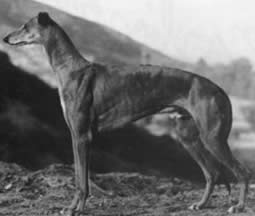 Hindquarters long, very muscular, powerful, well-bent stifles, hocks close
Hindquarters long, very muscular, powerful, well-bent stifles, hocks close
The croup or pelvis should be broad and long, flowing smoothly from the loin sloping gently downward to the low set tail.
The hindquarters have long bones that are well matched in length of thigh and second thigh. The muscles throughout the hindquarters have extremely well developed muscle. When viewed from the rear, the thighs and second thighs are straight, wide, and well muscled. The stifle is well bent and the hocks are low set, with prominent os calsis.
Greyhound feet are very important. They are strong, well arched, and thickly padded. “Rather more hare than cat” means that the two middle toes are longer than the outside toes, this arrangement helps to grab the ground. Flat splay feet or tight-knuckled ball feet are non-typical and should be faulted.
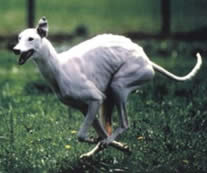
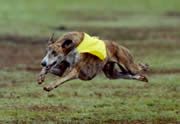
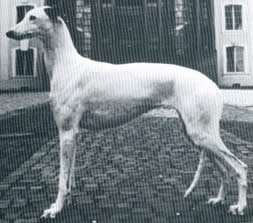 The coat is short, fine, and smooth with a satiny texture, and lies close to the skin. The tail is very long and tapering, carried low. It can be raised when excited but should not leave the body at an upward angle.
The coat is short, fine, and smooth with a satiny texture, and lies close to the skin. The tail is very long and tapering, carried low. It can be raised when excited but should not leave the body at an upward angle.
The weights stated in the AKC standard most closely fit the coursing dogs of the past two thousand years. Most modern Greyhounds are somewhat larger. The heights listed in the English standard are more representative of today’s show Greyhounds. Whether by height or weight, a Greyhound should not be so massive as to inhibit maximum functionality when coursing.
 Movement smooth, effortless, straight, and close to the ground. The Greyhound is built for the double suspension gallop, so the fast show ring trot is not natural to him. He performs better at the collected trot. The gait should be smooth, effortless, and close to the ground without lowering his body. Greyhounds should keep their topline and shape when trotting. Heads are carried only slightly higher than the withers. A hackney gait is non-typical as is single tracking or “rope walking”, and should be faulted.
Movement smooth, effortless, straight, and close to the ground. The Greyhound is built for the double suspension gallop, so the fast show ring trot is not natural to him. He performs better at the collected trot. The gait should be smooth, effortless, and close to the ground without lowering his body. Greyhounds should keep their topline and shape when trotting. Heads are carried only slightly higher than the withers. A hackney gait is non-typical as is single tracking or “rope walking”, and should be faulted.
For more information check
Be sure to also look at the educational pages on our website
